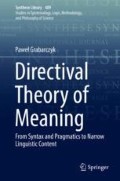Abstract
I start the chapter starts by reiterating the main assumptions of the new version of theory. Next, I show how the theory can be deployed in an example of a toy language and build definitions of meaning, synonymy and translation. Lastly, I get back to three problems we postponed: the problem of compositionality, the problem of meaning extension and the problem of how the nDTM can deal with closed languages.
Access this chapter
Tax calculation will be finalised at checkout
Purchases are for personal use only
Notes
- 1.
Admittedly, this is a rather odd sentence in a philosophical book on theory of meaning.
- 2.
The notion of figuring in a directive in an “essential manner” should be understood similarly to how it was understood in the original DTM. An expression figures in a sentence in an inessential manner if it can be replaced in the sentence by any other expression of the same syntactical category without changing the set of directives. Otherwise it figures in the sentence in an essential manner.
- 3.
I expand on this idea in Sect. 6.7 of this chapter.
- 4.
As we saw in Chap. 4, this part is especially important as it helps us escape some of the indeterminacy scenarios. As we are going to see in our toy language below, I emphasize this aspect of the theory by injecting the difference between acceptance and rejection directly into language matrices.
- 5.
In order to make the example more approachable I use abbreviated versions of directives. The full version of directive A1 should be understood the following way: “In any circumstances, the user accepts the sentence P(a) or she will be said by the community either not to take part in the semantic trial or not to use the term according to the meaning it has in L.” Full versions of all the other directives can be obtained by adding the same two disjuncts I have added to directive A1.
- 6.
This is an ideal example of an axiomatic directive . It can be argued that in a real case of a given natural language, there are no purely axiomatic directives and every directive belongs to a “mixed” category (explained below). For example, it is possible that the users won’t be seen as accepting a sentence while shaking their heads in disbelief. Still, this is not something we should worry about at this point because it does not change the theory and should be evaluated individually for every particular language.
- 7.
For the sake of simplicity, all examples used throughout the book comprise basic types of directives. It is nonetheless important to point out that the mixed category is important, as it most probably will be quite well represented in natural languages. What is important for us is that in contrast to the original DTM, the nDTM presents meaning directives in a way that makes the idea of mixed directives quite self-explanatory.
- 8.
By saying that two terms are synonymous if they can be mutually replaced in the language matrix without changing it.
- 9.
A good example of such a “semantic switch” is the pair of words “hund” and “dogge”, which originally meant “a dog” and “a hunting dog”, whereas in contemporary English it is the other way around.
- 10.
Conveying the meaning of the Japanese word “umami” is a good example of this (Lindermann et al. 2002).
- 11.
We assume here that the language in question uses negation in the same way we do.
- 12.
This differentiates it from the language user who is not expected to produce every possible acceptable utterance but the example is clearer this way.
References
Ajdukiewicz, K. (1931). On the meaning of expressions. In K. Ajdukiewicz (Ed.) The scientific world-perspective and other essays. Dordrecht: D. Reidel.
Buszkowski, W. (2010). O równoznaczności wyrażeń w ujęciu Ajdukiewicza. In J. Grad, J. Sójka, & A. Zaporowski (Eds.), Nauka − Kultura − Społeczeństwo. Księga jubileuszowa dedykowana Profesor Krystynie Zamiarze. Poznań: Wydawnictwo Naukowe Uniwersytetu im. Adama Mickiewicza.
Chomsky, N. (1957/2002). Syntactic structures. Walter de Gruyter.
Gärdenfors, P. (2004). Conceptual spaces: The geometry of thought. Cambridge, Mass: MIT press.
Henderson, D. (1994). Conceptual schemes after Davidson. Language, mind, and epistemology: On Donald Davidson’s philosophy. Dordrecht: Kluwer.
Lindermann, B., Ogiwara, Y., & Ninomiya, Y. (2002). The discovery of Umami. Chemical Senses, 27(9), 843–844.
Russell, B. 1940/2013. An inquiry into meaning and truth. Routledge.
Turing, A. (1950). Computing machinery and intelligence. Mind, 49, 433–460.
Author information
Authors and Affiliations
Rights and permissions
Copyright information
© 2019 Springer Nature Switzerland AG
About this chapter
Cite this chapter
Grabarczyk, P. (2019). New Directival Theory of Meaning. In: Directival Theory of Meaning. Synthese Library, vol 409. Springer, Cham. https://doi.org/10.1007/978-3-030-18783-5_6
Download citation
DOI: https://doi.org/10.1007/978-3-030-18783-5_6
Published:
Publisher Name: Springer, Cham
Print ISBN: 978-3-030-18781-1
Online ISBN: 978-3-030-18783-5
eBook Packages: Religion and PhilosophyPhilosophy and Religion (R0)

